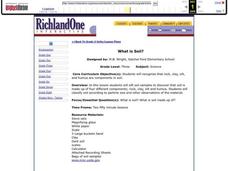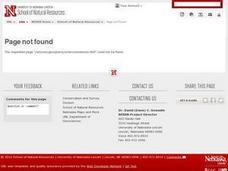Curated OER
Solutions
In this solutions worksheet, students read about solutions, solutes, and solvents. Students compare solutions with mixtures that are not solutions. Then students complete 10 fill in the blank, 12 matching questions, and 10 terms into a...
Curated OER
Solutions
In this solutions worksheet, students read about the characteristics that define a solution such as the solvent and the solute and the homogeneous mixture. They are given a chart with the differences between solution, colloids and...
Curated OER
Ancient River Civilizations
Students investigate the growth of the Ancient River Civilizations. For this world history lesson, students compare and contrast ancient and modern maps of the area of river civilizations.
Curated OER
Under Our Feet
Students investigate the forest ecosystem to learn of the living and non-living elements of the soil. In this ecosystem lesson, students examine soil for twigs, moss, fungi, leaves, roots and other matter. Students...
Curated OER
The Salmon Stream and Vegetation
Students explore the ecosystem and food chain by researching Pacific Salmon. For this fish habitat lesson, students discover the life cycle for salmon, where they spawn and what they eat to survive the harsh elements. Students...
Curated OER
Ecological Impact of River Dams
Students investigate their environment by completing an in-class experiment. In this ecological lesson plan, students define the roles of dams and how electricity is created by them. Students utilize plastic jugs, sand and...
Curated OER
Separating Soil from Dirt
You can use these lesson ideas to teach students about the importance and ecology of soil.
Curated OER
Chesapeake Bay
The Chesapeake Bay is the largest estuary in the United States. Explore its origins, organisms, and contributing rivers with this PowerPoint. It opens with several slides of general information on the formation of estuaries, then it...
Curated OER
Erosion Patterns
Fifth graders explore erosion and the different types of sediment. In this erosion patterns lesson plan students complete an activity and divide into groups and conduct an experiment.
Curated OER
THE TRICKLE DOWN EFFECT
Students participate in an exercise which demonstrates how sediments are deposited.
Curated OER
Determining the Percolation Rate of Soil
Students discover how water moves through different types of soils. In groups, they use the same sample from a previous activity and empty it into a milk carton in which they have layered with cheesecloth to determine the percolation...
Curated OER
What is Soil?
Third graders examine what makes soil by creating a Venn Diagram. In this Earth environment activity, 3rd graders identify the different components that soil is made from. Students bring soil from their homes to examine and create...
Curated OER
Rocks
Students use their five senses to experience different types of rocks. In groups, they compare and contrast the information they collected. They observe rocks in their local community and describe their uses to the class.
Curated OER
The"Dirt" on Soil
Students examine the three different types of soil and their physical properties. In this soil activity students design and implement a model of a water treatment plant.
Curated OER
Geography: why is Arkansas a great place to grow rice?
Second graders become familiar with the geography of Arkansas and analyze why it is a good place for certain crops to grow. In this rice lesson, 2nd graders list reasons Arkansas is a good place to grow rice. Students become...
Curated OER
Fossil Formation
Students discuss fossils. In this science lesson, students simulate fossils within Earth's layers by using gummy fish and bread.
Curated OER
Cradles of Civilization Information Sheet
In this early civilizations activity, students read 4 paragraphs about great river civilizations and then label them Nile, Tigris and Euphrates, Indus, and the Huang He River Civilizations. Student also complete a writing prompt on the...
Curated OER
Word Grid
In this soil worksheet, students find words that represent soil words in a word search. Students search for 9 words in this word search.
Curated OER
Making Sedimentary Rocks
Learners make models of sedimentary rock layers to explain how rocks form layers and represent ancient environments. Layers of sediment and fossils are added together to simulate the environment and connections to sedimentary rocks are...
Curated OER
Create a Soil Aggregate
Students simulate the conditions which occur in a soil aggregate. They explain how IPM affects the environment. They identify the cast of characteristics to develop their aggregate.
Curated OER
Lesson 3 - Water Above the Ground
Students define surface water, drainage basin or watershed. They investigate what affects runoff in a drainage basin. They complete lab sheets and worksheets.
Curated OER
Soil Erosion Demonstrations
Students conduct experiments demonstrating soil erosion and the benefits of conservation practices. Working in groups, they use topsoil and sand in shallow boxes as models to examine the effects of water on soil and sand with and without...
Curated OER
Creek Monitoring
Sixth graders conduct a variety of assessments at a local stream to determine if it is a suitable habitat for salmon. They measure temperature, tubidity, dissolved oxygen, pH levels, bacteria and nutrients. In this unit, 6th graders work...
Curated OER
Mountain Building
Teacher prepares four layers of Plasticine stacking layers on top of each other to create a model of how rocks within the earth can be folded creating anticlines and synclines below the surface and mountains and valleys on the surface.























